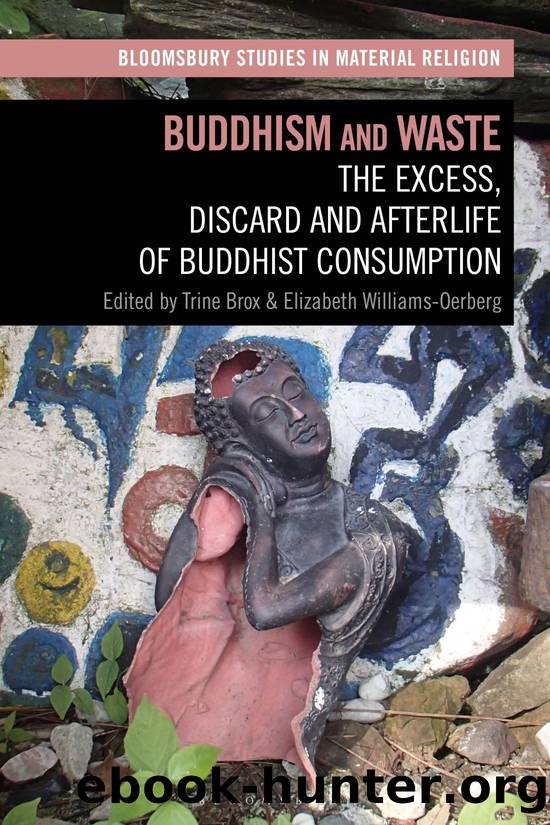Buddhism and Waste by Trine Brox

Author:Trine Brox
Language: eng
Format: epub
ISBN: 9781350195554
Publisher: Bloomsbury Publishing
Figure 3.4 Orphaned butsudan cry out to be adopted at the MÅâiliâili Hongwanji Mission in Honolulu, Hawaiâi. Photograph by the author.
Butsudan thus reveal the intriguing grey zone between the holy and the mundane. As Caroline Hirasawa and Benedetta Lomi (2018: 219) put it: âThe afterlives of sacred objects are especially useful in understanding how the lines between the sacred and the ordinary can be blurred or redrawn.â In many cases, butsudan lack adequate value for families to keep them. Yet, these cherished objects of their ancestors retain sufficient sacredness or meaning that families seek as their final resting place the middle ground of the temple, which is neither too close (as is the home), nor too far (as is the dump). Or for some, they are sufficiently scary for a temple to be brought in to handle the dangerous forces they contain, even though the families otherwise have little use for Buddhism.
What we have here is a journey towards waste occasioned by a transformation in value. When a butsudan is purchased or homemade, a level of value is placed upon the object itself, the uses to which it may be put, and the system in which it and its uses are embedded. The ritual work that owners reproduce (regularly or irregularly) animates this value, so that it moves from being latent, potential, and/or symbolic to becoming temporarily active.
If the butsudan lives long enough, it may outlast the life spans of those who normatively value it and are willing to activate its possible value through use. As the systems of value in which the butsudan was previously enmeshed deteriorate and die off, the butsudan as an object risks dying as wellâoften quite literallyâas physical destruction is ultimately the fate of many butsudan. Yet, even when the standard value of a butsudan has deteriorated, it often retains vestiges of its earlier values, such that it is not easily disposed of. Buddhism as a formal system of meanings may have passed away, but so-called superstition endures; those who used the butsudan may no longer be around to value it, but because they used to use it, it retains historic value as a relic of those lost loved ones. In other words, it ceases to have value as a Buddhist object but potentially acquires some degree of nostalgic value due to its association with former owners, or a degree of anti-valu e as the abode of spirits, that has to be dealt with carefully.
This mirrors the possible death and social dislocation process for humans in Japan, who may fall from memory after death and become muen botoke (spirits without connections). Here, muen butsudan are created. Like other ghosts, they must be treated with respect and caution (see Figure 3.5). Thus the butsudan sometimes avoids its immediate termination; if it is laid to final rest, this is often done in a respectful manner, moving it into the realm of the invisible sainted ancestors. Occasionally it is reborn, when someone is willing to invest it with Buddhist value and perform the necessary labor.
Download
This site does not store any files on its server. We only index and link to content provided by other sites. Please contact the content providers to delete copyright contents if any and email us, we'll remove relevant links or contents immediately.
The Way of Zen by Alan W. Watts(5809)
Ego Is the Enemy by Ryan Holiday(4000)
The Art of Happiness by The Dalai Lama(3391)
The Book of Joy by Dalai Lama(3233)
Why Buddhism is True by Robert Wright(2833)
Shift into Freedom by Loch Kelly(2698)
Spark Joy by Marie Kondo(2686)
Happiness by Matthieu Ricard(2529)
A Monk's Guide to a Clean House and Mind by Shoukei Matsumoto(2408)
The Lost Art of Good Conversation by Sakyong Mipham(2129)
The Meaning of the Library by unknow(2073)
The Third Eye by T. Lobsang Rampa(1887)
The Unfettered Mind: Writings from a Zen Master to a Master Swordsman by Takuan Soho(1863)
Anthology by T J(1758)
Red Shambhala by Andrei Znamenski(1752)
The Diamond Cutter by Geshe Michael Roach(1675)
Thoughts Without A Thinker: Psychotherapy from a Buddhist Perspective by Epstein Mark(1596)
Advice Not Given by Mark Epstein(1524)
Twilight of Idols and Anti-Christ by Friedrich Nietzsche(1498)
